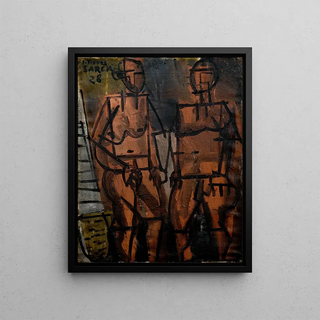Art print | Composition - Joaquín Torres-García Source: Reproduction | Composition - Joaquín Torres-García


View from behind

Frame (optional)
Composition Art print - Joaquín Torres-García – Captivating Introduction
The work "Composition" by Joaquín Torres-García, emblematic of the constructivist movement, stands as a true ode to harmony and balance. Through its geometric shapes and carefully chosen colors, the artist manages to capture the essence of an era while offering a profound reflection on structure and meaning. Contemplating this piece, the viewer is invited to immerse themselves in a universe where each line and color tells a story— a story that transcends time and space. The art print of "Composition - Joaquín Torres-García" allows you to appreciate this magic, providing a window into the creative genius of an artist whose impact still resonates today.
Style and uniqueness of the work
Joaquín Torres-García's style is distinguished by his ability to blend abstraction and figuration, creating a unique visual language that challenges the artistic conventions of his time. In "Composition," the artist uses rigorous geometric shapes, such as rectangles and lines, to establish a visual dynamic that immediately captures the eye. The colors, meanwhile, oscillate between vibrant hues and softer shades, creating a contrast that enhances the energy of the piece. This play of colors and shapes is not merely aesthetic: it reflects an intellectual quest, an exploration of the relationship between art and reality. Torres-García encourages us to question our perception of the world, to see art as a means of understanding the complexity of our existence.
The artist and his influence
Joaquín Torres-García, an emblematic figure of Latin American modern art, managed to establish himself as a pioneer through his innovative vision. Born in Uruguay, he was deeply influenced by European artistic movements, notably cubism and constructivism, which he integrated into his own language. His work goes beyond mere aesthetics; it embodies a philosophy, a way of thinking about art as a tool for social transformation. By founding the Torres-García Workshop in Montevideo, he also played a crucial role in training young artists, passing on his passion for art and his

Matte finish

View from behind

Frame (optional)
Composition Art print - Joaquín Torres-García – Captivating Introduction
The work "Composition" by Joaquín Torres-García, emblematic of the constructivist movement, stands as a true ode to harmony and balance. Through its geometric shapes and carefully chosen colors, the artist manages to capture the essence of an era while offering a profound reflection on structure and meaning. Contemplating this piece, the viewer is invited to immerse themselves in a universe where each line and color tells a story— a story that transcends time and space. The art print of "Composition - Joaquín Torres-García" allows you to appreciate this magic, providing a window into the creative genius of an artist whose impact still resonates today.
Style and uniqueness of the work
Joaquín Torres-García's style is distinguished by his ability to blend abstraction and figuration, creating a unique visual language that challenges the artistic conventions of his time. In "Composition," the artist uses rigorous geometric shapes, such as rectangles and lines, to establish a visual dynamic that immediately captures the eye. The colors, meanwhile, oscillate between vibrant hues and softer shades, creating a contrast that enhances the energy of the piece. This play of colors and shapes is not merely aesthetic: it reflects an intellectual quest, an exploration of the relationship between art and reality. Torres-García encourages us to question our perception of the world, to see art as a means of understanding the complexity of our existence.
The artist and his influence
Joaquín Torres-García, an emblematic figure of Latin American modern art, managed to establish himself as a pioneer through his innovative vision. Born in Uruguay, he was deeply influenced by European artistic movements, notably cubism and constructivism, which he integrated into his own language. His work goes beyond mere aesthetics; it embodies a philosophy, a way of thinking about art as a tool for social transformation. By founding the Torres-García Workshop in Montevideo, he also played a crucial role in training young artists, passing on his passion for art and his






